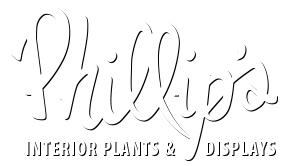This post was originally written by Jean M. Berg, General Manager of Phillip’s Interior Plants & Displays, and appeared as an article in the Spring 2017 edition of the Commercial Voice.
The American biologist and naturalist E. O. Wilson popularized the hypothesis that humans possess an innate tendency to seek connections with nature and other forms of life. Pantone confirms this thinking with their selection of “Greenery” for the color of the year!
Green matters in our world today. Without plants and the oxygen they produce we would not survive as a species. As important as that is, it isn’t just about survival! As humans we strive to improve our lives including our work environments. Biophilic design in our work place — whether a window to the outside, a fish tank or a plant in our office — affects our neurological and physiological systems in positive ways. Studies have shown that these feelings contribute to positive outcomes in our work lives and environments.
It has long been known that plants bring beauty into interior spaces. A variety of studies also conclude that a view to the outside natural world or bringing nature inside reduces stress, increases productivity, reduces absenteeism and overall improves job satisfaction. All of these translate into reduced costs and increasing profits for all sectors of business, healthcare, and retail entities.
There are three components of Biophilic Design: Nature in the Space, Natural Analogues, and Nature of the Space. Nature in the Space refers to the use of plants, water and animals in the interior environment. These direct elements produce the best biophilic impact. Natural Analogues are replication of nature in a space — whether through artwork, decor or ornamentation — that is incorporated into our surroundings. The Nature of the Space deals with how humans respond to different configurations within interior environments. We have all experienced building that are more inviting and pleasant to be in. These spaces tend to incorporate elements that connect us to the natural world. This takes conscious thought, effort, and implementation.
We are innately connected to nature and derive many benefits from that connection. Imagine having the opportunity to go for a walk in the woods or hiking in the mountains. These occasions rejuvenate and inspire us and these feelings of well-being are important for our long term health. These same positive results can be replicated indoors by paying attention to the environments that our employees, tenants, and visitors experience. Economic gain is the added benefit to Biophilic Design! At Phillip’s Interior Plants we are seeing a resurgence of ‘greenery’ and nature in business environments. Live green walls and preserved moss walls are especially popular and can be works of art!







